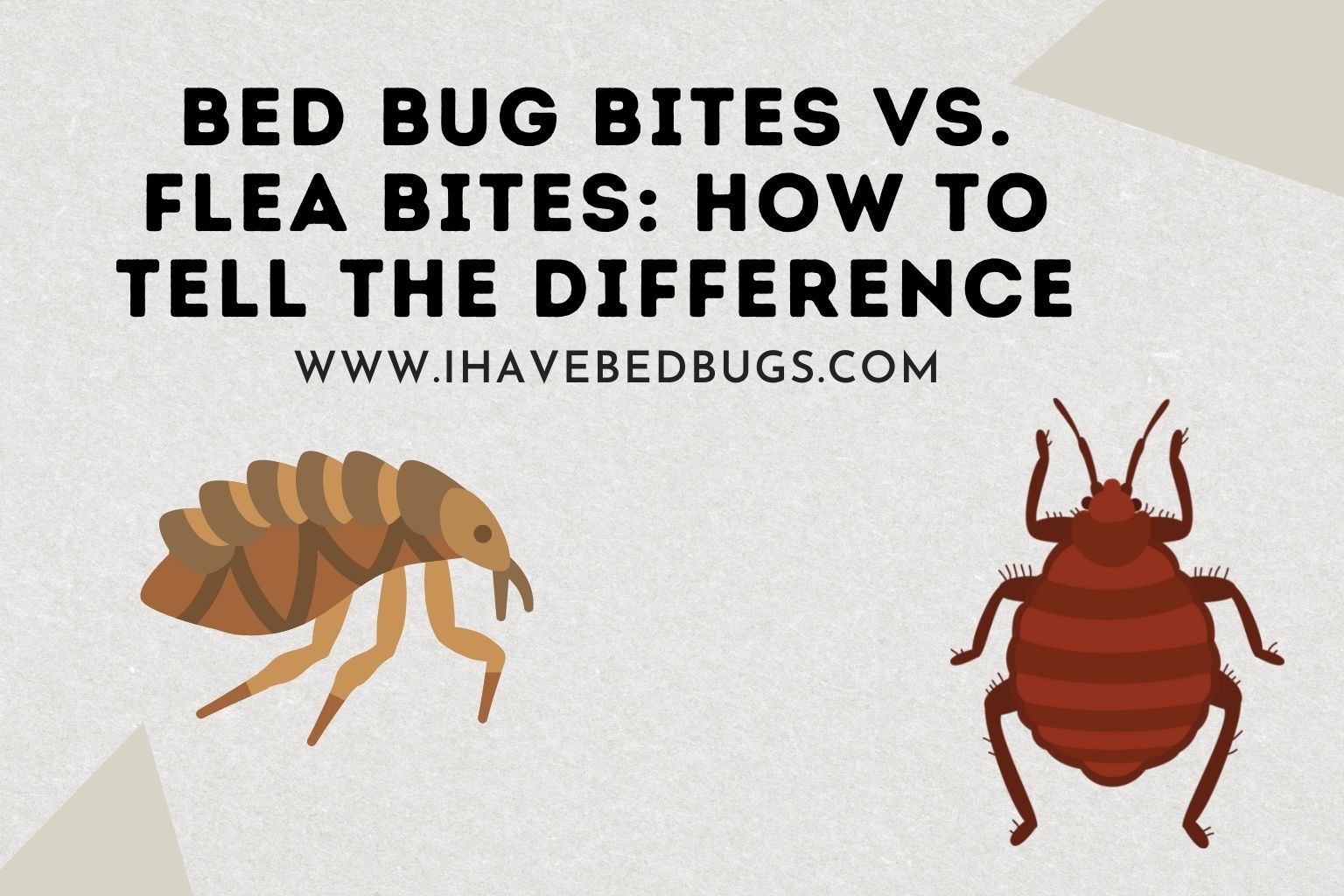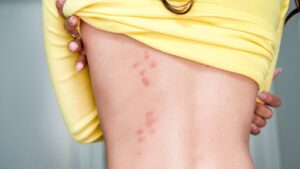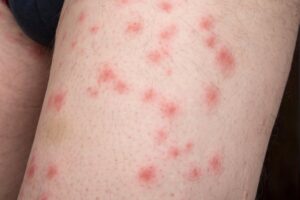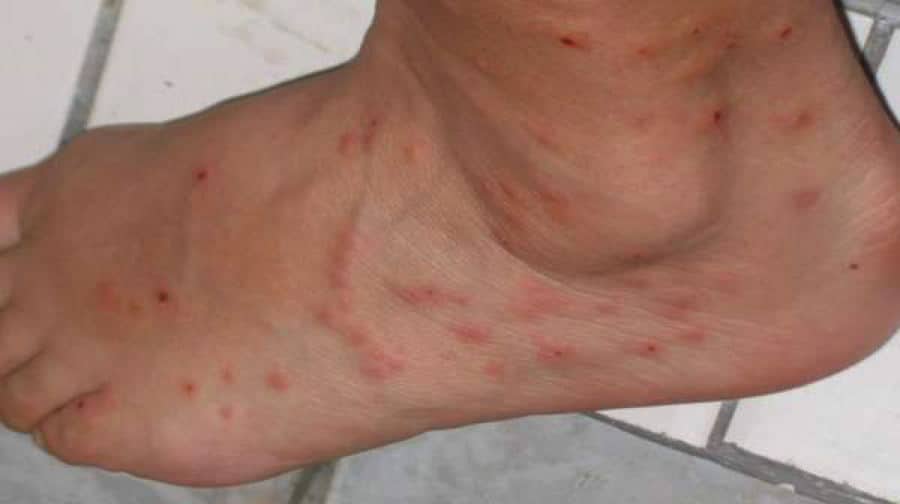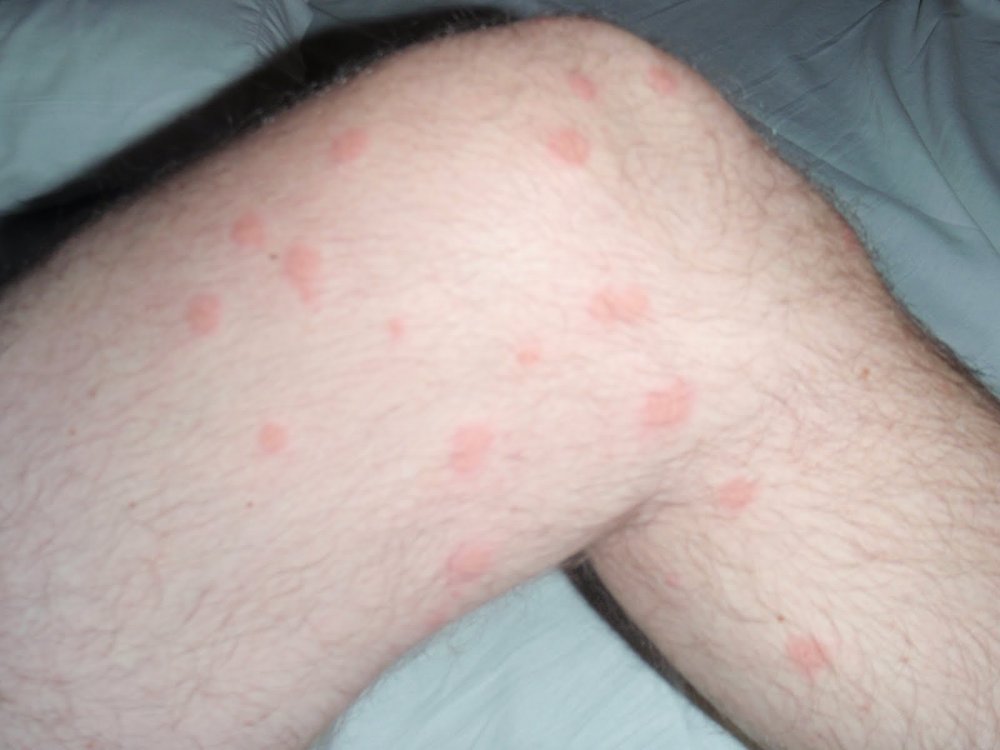The first step is to determine the kind of bugs you are dealing with when trying to get rid of bugs. Unfortunately, this is easier said than done, especially because many bugs have similar bites. However, if you pay close attention to the bites, you can pick out subtle differences that will help you devise the most efficient course of action.
In line with this, most people often confuse the bite of fleas and bed bugs bed. Luckily for you, today, we’ll delve deeper and help you differentiate between bug bites and flea bites and learn how to treat bed bug bites.
What Does a Bed bug Look Like?
To take care of a bedbug problem, you first need to understand a bed bug’s appearance. An adult bed bug is usually equivalent to the size of an apple seed. It is flat and paper-thin, brownish in color, and deep red after feeding. A bed bug has specialized mouthparts that allow it to extract blood once they begin biting. Since the bite is not painful, it can go unnoticed for a couple of days. And because of this, the bed bug can feed for up to 10 minutes. Unlike fleas, bed bugs do not hang around after feeding but rather run back to their hiding place.
What Do Bed bug Bites Look Like?
Most people don’t develop any symptoms when bitten by a bed bug. But for those that do, here’s what they look like:
- Bed bug bites are red and swollen and with a dark spot at the center of every bite.
- The bites are arranged in clusters or a line. Usually, multiple bites are grouped. This is because bed bugs cannot fly and, as such only feed on localized spots.
- The bites tend to appear on exposed areas on the skin, including arms, neck, hands, face, shoulders, and legs. However, they can bite any part of your body and even under the clothes.
- The size of the bed bug bite depends on several factors. First, when feeding, bed bugs inject saliva and anticoagulant. The anticoagulant is responsible for the allergic reactions that people experience. The amount of anticoagulant, along with an individual’s sensitivity to it, determines how big or small the bite grows.
Where Can You Find Bed bugs?
Live bed bugs gravitate to cool and dark spots. So you can usually find bed bugs in your bed frame, mattress seams, headboards, behind picture frames, electrical sockets, box springs, closets, and furniture.
Signs of a Bed Bug Problem in Your Home
If you wake up with an itchy bump that you didn’t have before going to bed, you may have a bed bug problem. Another bed bug identifier is bloody or reddish stains on the beddings or mattress cover and a foul smell (if the infestation is well advanced). You can also diagnose the bite by looking for the insects infesting your home. Some other signs to look out for include:
- Rusty-colored fecal material.
- A sweet musty odor
Bed Bug Bite Symptoms
According to the Centers for Disease Control and Prevention, there is no evidence of bed bugs transmitting disease. However, they can be a health nuisance for most people. For starters, bed bug bites almost always cause some level of discomfort, including inflammation and itchiness. The symptoms include:
- A raised and itchy bump
- A painful and burning sensation
- A red, itchy bump
- Small red hives or blisters
Though it might be rare, some individuals develop some severe symptoms and reactions, including:
- Large blisters
- Fever
- Swollen tongue
- Difficulty breathing
- Irregular heartbeat
- Increased chance of infection, especially with excessive scratching
- Decreased wellbeing
With long-term exposure to bedbug and flea infestations, difficulty sleeping may occur. As a result of lack of sleep, some people may develop anxiety, general fatigue anxiety, and reduced immunity. And last but not least, given the association of bed bugs to uncleanliness, these can add to low self-esteem and depression. In addition, given multiple bites, itchiness, and scratching, the skin can be compromised.
The thought of having bed bugs feed on you every night can be stressful. And since bed bugs feed at night (though not always), some people will stay awake in the hopes of avoiding being a meal.
Bed Bug Bites Treatment
Usually, bed bug bites heal between one and two weeks. However, to help relieve itchiness and other symptoms, you can:
- Take over the counter oral antihistamine to help reduce intense itching and burning
- Apply calamine lotion or an anti-itch cream to the bed bug bites
- Use over the counter pain relievers to relieve pain and swelling
In situations where the bites cause severe allergic reactions, you should call 911. And to avoid the risk of an infection, you should wash the bites with some soap and water and try your best not to scratch them.
In addition to OTC medication, some home remedies can help to relieve the symptoms. Generally, bed bugs bites start to itch within 2 to 3 hours after being bitten. To soothe the itchy bumps, apply:
- Some essential oils, including chamomile oil and camphor oil
- A paste of baking soda and water
- An ice pack wrapped in a towel
- Anti-itch creams
Bed Bug Bites Pictures
What is a Flea?
A flea is a parasitic insect that feeds on the blood of birds and mammals. Entomologists argue that there are more than 2,500 flea species in the world. In the U.S., the most common species are the Ctenocephalides felis (cat flea), which affects animals but can also feed on humans. Adult flea measures between 1/12 and 1/8 inches long. It is oval, wingless, and laterally flat. Like bed bugs, fleas have a reddish-brown color. They are actual insects and can jump up to 200 times their body length.
Related Content:
41 Home Remedies for Bed Bugs
15 DIY Bed Bug Heaters
Bugs that Look Like Bed bugs: 12 Insects Mistaken for Bed bugs
Life Cycle of a Flea
Flea control is a tricky business but doable. The key to controlling fleas and preventing flea-borne diseases in your home is by understanding their life cycle. Sure, it might be gross, but you need to think about how they reproduce and feed.
An adult flea will lay eggs in its host’s hair. A female flea can lay up to 50 eggs a day. On average, it’s been discovered that they can lay 27 eggs for 100 days. These are over 2,700 eggs that can potentially end up on your carpet, bed, or floor when your dog scratches, lie down, or shakes.
The flea egg hatches between 1 and 6 days into larva, which then spins into a cocoon for up to two weeks. Eventually, the larva matures into an adult and waits for a host to pass close by. An adult flea can survive for weeks or months in the right conditions.
What Does a Flea Bite Look Like?
Flea bites look like tiny red bumps. You will notice flea bites in two or three clusters with some redness around. At times, they have a light halo, and you appear around the lower legs, elbows, waist, ankles, armpits, and feet.
For those allergic to flea bites, the area of redness is larger, with a tiny pimple at the center. Also, depending on your reaction and how much you scratch the bites, the redness can last between a couple of hours and several days.
Why and When Fleas Bite
Fleas bite for survival. The adult female needs blood to reproduce and can feed two or three times a day. Through evolution, fleas can now store 15 times more blood compared to their weight. Moreover, they have many spikes on their legs, allowing them to stick firmly to a host. After penetrating the skin (human or animal), they inject saliva containing about 15 different natural chemicals that lead to severe allergic reactions, especially in our furry friends.
We should also mention that fleas tend to bite some humans more than others. Like bedbugs and mosquitoes, these biting insects find human hosts based on the chemical cues (volatile organic compounds) they release. The human VOC profile is your skin’s odor and contains about 400 compounds that make it unique. So when a flea opts to bite you and not your friend, it’s because they are attracted to your VOCs.
Do Fleas Bite Humans?
Flea bites aren’t common in humans because many flea species prefer feeding on pets. However, they do bite humans (usually without turning them into hosts). For instance, the cat flea will only feed on human blood if there is no pet around.
How Do Humans Get Fleas?
A flea can jump over 200 times its body length. If we transpose this to a human scale, this is almost 400 meters high. The long jump Olympic record is less than ten meters. With these figures in mind, it’s easy to understand how a flea can jump from your dog or cat to you. Aside from pets and humans, fleas also live in other animals and the backyard.
How Long Do Flea Bites Last?
A flea bite only lasts for about a day or two (in individuals that don’t have an allergic reaction to the bite). However, for those who are sensitive and have adverse reactions, characterized by itching and red rashes, the bites can last between 1 and 2 weeks. On some rare occasions, the bites can last even longer.
Flea Bite Symptoms
Flea bite symptoms can occur immediately or after a while. They include:
- Itching
- Hives
- Swelling around the bite
- Red spots
Those who are more sensitive to the bites will have allergic reactions, including:
- Swelling of the tongue and lips
- Difficulty breathing (wheezing and shortness of breath)
- Nausea
- Chest pain
- Dizziness
These allergic reactions are medical emergencies, and as such, you should call 911.
How to Treat Flea Bites
Usually, a flea bite will subside even without treatment. However, there are ways to help ease the discomfort and irritation and speed up the healing process.
First, medical experts suggest that you resist the urge to scratch the bites. Instead, wash the flea bites with antiseptic soap to help in reducing the risk of infection, place an ice pack on the bites to reduce swelling, and use anesthetic creams and calamine lotions to treat the itchiness in the affected area.
You can see your pharmacist for advice on the antihistamine medication you can take to reduce the swelling. It would be best if you also saw a doctor for a possible tapeworm infection, as fleas can transmit them through their bites. Most importantly, if the symptoms worsen and you start getting a discharge from the bites or signs of a skin infection, seek medical attention immediately for prescription antibiotics.
How to prevent flea bites
In sports, an offense is the best defense. This is true even when dealing with flea bites. To prevent a flea infestation in your home, you should do the following:
- Wash your pet’s bedding once every week and vacuum the carpet to remove flea eggs. When you finish vacuuming, be sure to dispose of the vacuum bag properly.
- Tumble dry the pet bedding at high temperatures to kill flea eggs and adult fleas.
- Treat outdoor areas with insecticides specifically designed to kill fleas.
- Prevent animals carrying fleas from getting into your garden or property by putting up a high wall or fence.
- Clean your pet thoroughly with warm water and shampoo to kill fleas. Additionally, you can speak to a vet about the best flea treatment for your pet.
Flea Bites Pictures
If fleas have bitten you, you might experience symptoms as seen in these images:
Common Questions
Do bed bug bites transfer diseases?
Though bed bugs can be a nuisance and an inconvenience, they don’t spread disease. This is because bacteria and viruses can’t survive in their bodies. Moreover, a bed bug feeds for about 10 minutes and is full for the next couple of days. During this time, the blood it feeds on is digested. Therefore, the only health risk a bed bug bite puts you in is that of an infection because of the itchiness. For this reason, you are advised not to scratch your bed bug bites.
What kills bed bugs instantly?
Before we get into that, you should note that there’s a difference between killing bed bugs and getting rid of a bed bug infestation.
Getting rid of a bed bug infestation is a process, even when using treatment methods that quickly kill bed bugs. Why? Well, bed bugs infesting your home are all at different stages. For instance, you might have bed bugs in the egg stage, some in the larva stage, and some adults at the time of treatment. So while the treatment method might kill adult bed bugs, the larva and eggs might survive to re-infest your home. Therefore, multiple treatments and follow-ups are required to ensure successful treatment.
As for the treatment options that kill bed bugs instantly, the most preferred is heat treatment. It is effective and should only be done by a professional. The treatment involves raising the temperatures to 117 degrees Fahrenheit in spaces where bed bugs can hide, including cracks in the walls, crevices, beds, closets, furniture, and mattresses.
Professionals require proper equipment to raise the temperatures without setting the house on fire. You can also consider using a steam cleaner and a dryer as an alternative (but still effective) bed bug killer.
Can you tell the difference between bed bug bites and mosquito bites?
Just like flea bites, mosquito bites also look like bed bug bites with a point in the middle of the actual bite(many people confuse the two). What makes it even harder to differentiate them is that different people have different reactions to insect bites. Luckily, there are general characteristics that you can use to tell different insect bites apart.
Below are the top 5 differences
1. Bed bug bites form in clusters
This is by far the best way to differentiate them. Mosquito bites are random and isolated. On the other hand, bed bugs bite the same area multiple times, creating a cluster. Also, bed bug bites can appear in a straight or zig-zag line.
And though bed bugs usually feed on exposed body parts, they can also crawl under the clothes for a bite. Mosquitoes only feed on exposed skin.
2. Bed bug bites Vs. flea bites
Though you despise mosquito bites, they have a huge advantage over bed bug bites because they disappear faster (if you do not disturb them). Also, the itchy sensation that accompanies the bites only lasts for a short while.
3. Mosquito bites become itchy faster
If you’ve ever had a mosquito bite, you can attest to the fact that they get itchy fast (almost immediately). The itching sensation will come even before the skin swells and turns red.
But as for a bed bug bite, you will see the rash or bump from the bite before you start experiencing an itchy sensation. The itchy welts may pop up a couple of days after the bite and sometimes even 14 weeks later.
Surprises may accompany 4. Bed bug bites on the bed
One sure way of telling that you are dealing with a bed bug is when you come across black and red stains on the bedsheets. If you discover bite marks and stains on your bed sheet, then you are dealing with bed bugs and not mosquitoes.
The red stains are formed by the blood ingested by bed bugs, while the black stains are their feces. Usually, bed bugs poop while they feed to create more room for blood. Yes, it’s gross, but on the upside, it helps you determine what you are dealing with.
5. Sometimes, bed bug bites come with rashes
Bed bug bites can be accompanied by rashes depending on one’s immune system and reaction to the bite. It also depends on how much anticoagulant the bed bug injected into the skin while it was feeding. If you develop a scratch, you should avoid scratching and seek medical attention soon.
Can you have just one bed bug?
Well, if we are being positive, it’s possible to have a single bed bug. However, given the fact that they love to hide in dark spaces, the moment you see a bed bug in your home, it’s a sign that you have a bed bug infestation on your hands.
As such, you should act quickly to get things under control. The more you delay, the bigger the infestation grows and the more money you will spend on a professional to get rid of them. So, rather than being positive about it, you’d rather overestimate the infestation than underestimate it and not use enough force to get things done.
Can fleas be mistaken for bed bugs?
Yes. And in fact, if you are encountering the two for the first time, you may not know what you are dealing with. But though they are similar, they also have some subtle differences to tell them apart.
As mentioned earlier, both fleas and bed bugs love feeding on warm-blooded animals. However, fleas prefer to feed on furry animals, while bed bugs prefer feeding on humans. But when times are tough and their preferred food choice is unavailable, they move on to the closest food source. Thus, you find fleas feeding on humans and bed bugs feeding on your cats and dogs in such situations.
Fleas live for a couple of months without needing a host in their pupa stage. However, once they transition into adults, they have to feed within two weeks to survive.
On the other hand, adult bed bugs can survive up to 12 months without a single meal. But even with such resilience, they cannot reproduce without feeding.
Also, fleas can lay a maximum of 300 eggs in a week. A bed bug lays 200 eggs in its lifetime.
Bedbugs crawl and can’t fly, but fleas can jump 200 times their body length (13 inches on average). Their powerful jumps help them to move from one host to another.
Do fleas bite in threes?
We’ve pointed out that flea bites occur in a pattern. What we didn’t mention is that they usually happen in threes. They can be in a cluster or a line (a few centimeters apart). The lesion patterns are called breakfast or a meal cluster, a dinner configuration, or lunch.
Why do fleas feed in this pattern? Well, for the most part, it’s not because they want to, but they have to look for the best location. Below are some quick reasons why the patterns appear:
Exploratory probing
A flea can make several lesions before sucking blood. It does this to find the best location and the best blood vessel. As it probes, it injects the salivary apyrase into the skin. The apyrase has anticoagulant properties, which help the flea to locate and suck blood. However, this probing process is enough to cause a bite reaction.
Disruptions during feeding
Fleas start feeding as soon as they land on the skin. However, they get disturbed by human movements. Once interrupted, the flea has to get to another location. The subsequent bites are usually close to each other. If the interruptions are too much, the flea might end up taking refuge in your clothing and feeding periodically.
Are fleas dangerous?
Unlike bed bugs, fleas are known to transmit diseases. Below are some of the diseases they carry:
Bubonic plague
This is by far the most known disease transmitted by fleas. Back in the 14th century, the disease was called the Black Death. Then, it was a huge epidemic that killed 25 million people and about 50% of the European population. To date, the plague still exists. Every year, there are reports made in the U.S. The plague is harbored by rodents but transmitted by fleas that bite them, which they later transfer to humans and pets. Luckily, there are antibiotics available to treat the disease.
Murine typhus
This disease is rare. However, every year, there are reports made in the Southwestern portion of the U.S. The disease is usually present in areas infested with rats. The most common symptoms include a severe headache, high fever, weakness, nausea, and chills. But like the bubonic plague, there is treatment, and people often respond faster to the treatment.
Tungiasis
This disease is rare in the U.S. However, because of the high international traffic from the tropics, including Central America, the Caribbean, and West Indies, it’s a disease you should know about. The disease is transmitted via the burrowing flea. It’s also common with the sand flea and the chigger flea. It affects human feet where fleas anchor and burrow beneath the epidermis. Therefore, travelers are often advised to wear closed shoes as they walk on the sandy regions of the tropics.
Tularemia
This is a serious illness that is prevalent in North America. It is caused by Francisella tularensis and in rodents. Aside from fleas, it can also be transmitted by a tick bite. The common symptoms often include chills, diarrhea, fever, gradual weakness, and joint pain. Though the disease is not infectious, affected persons should seek medical attention for treatment.
How do I know my dog has fleas?
A flea bite on a dog looks more like a bed bug bite on human skin – a small red and raised dot on the skin. Generally, the bits are smaller than those from other insects, but they can swell after scratching. Dogs that are more allergic to flea bites end up with even larger bite marks.
While they can be visibly large, it’s hard to notice them under the fur unless you are actively looking. But since they are itchy, you’ll notice something is a miss by how much your dog is scratching.
With that said, below are some signs your dog has fleas:
- Hair loss
- Itching and scratching
- Chewing and biting the skin
- Irritated skin
- Scabs
Other signs your dog has fleas
Aside from the symptoms mentioned above, other great ways of determining if your dog has fleas include looking for adult fleas on their skin or their droppings.
Fleas love to infest the ears, neck, abdomen, base of the tail, and lower back. Fleas are about 3 millimeters long, and their dark brown bodies are easy to spot again the dog’s skin/brightly colored fur.
If the fleas aren’t active, you can check your dog’s droppings. Flea dirt (flea droppings) looks like scattered flecks of pepper on your dog’s skin. The specks mostly dried blood, and if you pick them up with a wet paper towel, they’ll turn brown and then red after rehydration.
The best way to search for fleas on your dog is to use a flea comb. Flea combs have fine teeth which pick up flea dirt and adult fleas, making it easier to spot them.
Complications caused by flea bites in dogs
Fleas are super irritating and can cause serious complications. As such, it’s important to prevent and control fleas at all costs. Some of the main concerns include:
- Flea tapeworms – as a dog bites at a spot to ease itchiness, it may ingest fleas. When this happens, they ingest another unwanted parasite – tapeworms. Tapeworm eggs move from the stomach to the small intestines, where they hatch and grow into adults. The good thing is that tapeworms aren’t harmful and are usually easy to remedy.
- Anemia – fleas have a big appetite for blood. They can feed on blood up to 15 times their body weight in a single day which is equivalent to a man weighing 100 pounds consuming 1,500 pounds of food in a day.
- Dermatitis – this is a common skin disease in dogs in the U.S. An allergic reaction to chemicals fleas causes the disease to inject into the skin, which leads to irritation, itchiness, scaly skin, hair loss, and other secondary skin infections.
Related Content:
41 Home Remedies for Bed Bugs
15 DIY Bed Bug Heaters
Bugs that Look Like Bed bugs: 12 Insects Mistaken for Bed bugs
Do dogs and cats carry the same type of fleas?
Dog fleas (Ctenocephalides canis) and cat fleas (Ctenocephalides felis) are different. However, these differences are only visible under a microscope. Despite these differences, cat fleas can infect humans, dogs, and other animals. In North America, most flea problems are from cat infestations. If your pet shows signs of fleas, you should take them to a vet for guidance.
And there you have it, a complete breakdown of everything you need to know about flea and bed bug bites. Note that in both cases, scratching will only make the bites worse and will leave you vulnerable to infections. Once you receive these bites, call in a pest exterminator to handle the infestation for you. Treating your bites will not do anything to get the infestation under control. Remember to work fast and hard.
Sources:
- https://www.medicalnewstoday.com/articles/318083
- https://blogs.cdc.gov/niosh-science-blog/2011/09/29/bed-bugs/
- https://www.healthline.com/health/bed-bug-bites
- https://www.webmd.com/skin-problems-and-treatments/guide/bedbugs-infestation#1
- https://www.healthline.com/health/flea-bites
- https://www.healthline.com/health/flea-bites-vs-bed-bug-bites
- https://www.medicinenet.com/flea_bites_in_humans/article.htm
- https://www.betterhealth.vic.gov.au/health/ConditionsAndTreatments/fleas
- https://www.orkin.com/other/bed-bugs/bedbug-bites

